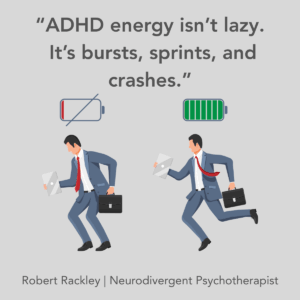ADHD Energy: Why It Feels Like Sprints, Bursts, and Crashes
For many adults, energy feels steady. But for adults with ADHD energy, it rarely works that way. Instead, it shows up in unpredictable sprints, bursts, and crashes. One day there’s unstoppable drive, the next brings complete exhaustion.
This pattern is often misunderstood as laziness or lack of discipline. From a therapist’s perspective, it’s not a character flaw — it’s the ADHD brain managing dopamine regulation and focus in a different way.
Why ADHD Energy Feels So Inconsistent
The ADHD brain is wired for interest and stimulation. When dopamine is high, energy and motivation can soar. But once that dopamine drops, the crash can feel sudden and overwhelming.
This is why many adults experience ADHD fatigue and shame around their energy levels. Society values consistency, but for people with ADHD, consistency looks different. The ups and downs aren’t failure — they’re part of the way the ADHD nervous system works.
ADHD and Burnout
One of the biggest risks for ADHD adults is burnout. Without understanding these energy cycles, people often try to push harder or mask the exhaustion. That leads to crashes, guilt, and even more shame.
But ADHD burnout isn’t inevitable. With the right strategies, you can reduce overwhelm and build a healthier relationship with energy.
Strategies for Managing ADHD Energy
The real skill isn’t about “trying harder.” It’s about learning to work with ADHD rhythms instead of against them. Here are some evidence-informed strategies for ADHD energy management:
Work with bursts of energy. Use high-energy windows for deep focus, problem-solving, or creativity.
Build in recovery before burnout. Don’t wait until you crash — schedule breaks, rest, and downtime as part of your daily routine.
Honour your natural rhythms. Notice when you have more energy (morning, evening, after movement) and align tasks with those patterns.
Replace shame with self-compassion. In therapy, I often see how much relief comes when people stop blaming themselves and instead adopt strategies that fit their unique brain.
From Shame to Strategy
Understanding ADHD energy cycles reframes the story. It’s not about being inconsistent or undisciplined — it’s about recognising that your brain has a different rhythm.
When ADHD is approached this way, energy becomes less about shame and more about strategy, self-compassion, and long-term balance.
If you’ve ever felt frustrated by the ups and downs of ADHD energy, remember: you’re not broken — you just need tools that fit your brain.
ADHD Energy FAQ
Why is my energy so inconsistent with ADHD?
ADHD affects how the brain regulates dopamine, which plays a role in motivation and energy. This can create patterns of bursts of energy followed by sudden fatigue.
Does ADHD cause fatigue?
Yes, many adults experience ADHD fatigue, often linked to overstimulation, emotional regulation demands, and burnout from masking symptoms or pushing through exhaustion.
How do I manage ADHD energy crashes?
Plan recovery breaks before a crash happens, use high-energy times for important tasks, and develop routines that support rest and self-care. Consistency for ADHD looks different, and that’s okay.
Can ADHD lead to burnout?
Absolutely. ADHD burnout often comes from trying to keep up with “neurotypical” levels of energy or focus. Recognising your unique energy rhythm and building strategies around it can help prevent long-term exhaustion.
What are some strategies for ADHD energy management?
Use bursts of focus for priority tasks.
Break tasks into smaller steps to conserve energy.
Schedule rest proactively, not just when you’re exhausted.
Honour your own rhythms instead of fighting them.

